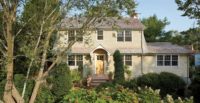From the tree-lined road shading houses of different historic styles in a picturesque village on Long Island’s South Shore, a freestanding study for an art historian looks quite unprepossessing. The cottage, which also includes a film-screening area for her husband, a businessman, is nestled at the rear of a grassy 2.2-acre property. Although it is difficult to see the studio from the street past the trees and the vegetable garden, the studio’s prowlike front hardly resembles the American residential architecture surrounding it. A discreet but unfamiliar-looking object, the studio’s angular walls and sloped roof, both clad in copper, converge on a tall, narrow door some 12 feet in height.
As it turns out, however, this retreat is actually more like a tree house than a cottage: Entering the small, high vestibule, one immediately confronts a narrow wood stair leading up to the second-level work space. At the rear of this loftlike expanse, the historian’s desk looks out through a 16-by-7-foot window directly onto a grove of trees with a stream in the near distance.
Andrew Berman, AIA, the New York architect who designed the cottage, saw the door as a threshold, while the window in the study signified one’s arrival. “As you go from the vertical entry to a horizontal aperture,” Berman says, “the building becomes a volume describing the transition.”
Berman, who in 2003 designed the Center for Architecture for the New York Chapter of the American Institute of Architects, demonstrated in that project his feeling for the interpenetration of space and light and the way its occupants would move through the building. The clients for the Long Island retreat were impressed by the center, and continued to follow the young, Yale-trained architect’s career. (They aren’t the only ones interested: The Architectural League of New York chose Berman’s firm as one of its “Emerging Voices” for its 2009 Spring lecture series.)
In filling out the three-dimensional space between the tall, narrow entry and the elevated, expansive window, Berman designed a V-shaped wedge and appended it to a more or less trapezoidal form. Where the sloping roofs of the two meet, he placed a transverse skylight to act as a hinge element. “The amount of daylight entering the second level is such a welcome surprise,” says the client, who uses the work space only during the day. At night, the sitting area at the opposite end of the room functions as a screening room for films.
In order to create the structure for the geometrically eccentric house, Berman had a series of five steel portal frames shop-built, and then erected on the site in a day. “I thought we were building an airport,” quips the husband. At the rear of the cottage, where the study juts into the trees, Berman cantilevered the space 14 feet at a height of 9 feet above the ground. Then he filled in the spans between the frames with wood studs, insulated the house, and sheathed the interior generously in Douglas fir. The exteriors are clad in flat-seam copper, which is patinating naturally. “I wanted copper after having visited Herzog & de Meuron’s de Young Museum in San Francisco,” says the art historian. For his part, Berman desired all the surfaces of the building to be clad in the same material to erase the distinction between the roof, walls, and soffits. Copper fit the bill, according to Berman, because it patinates gradually over time and seems to change color and reflectivity depending on the light.
Although the house is small (850 square feet for the library and associated spaces; 300 square feet for the mechanical room and potting shed at grade), zoning required that any cottage on a discrete piece of property in the village be treated as a full house with a kitchen and two bathrooms. On top of that, the house had to pass close inspection by a very protective architectural review board for the town, even though it wasn’t in the historic district. “It was a struggle that went on for months,” says the art historian. “They thought it looked too Modern.” After the too-Modern house was finished, and landscaped by Eleanor McPeck with John Beitel, however, she felt vindicated. “The neighbors have been congratulating us,” she says. “They find it beautiful.”










Post a comment to this article
Report Abusive Comment